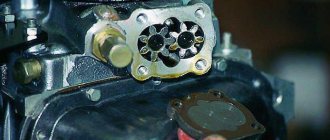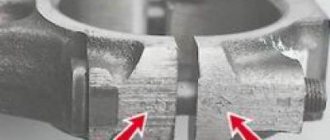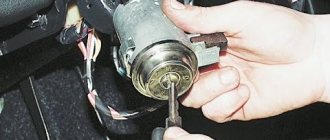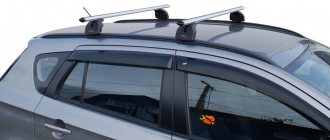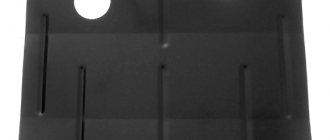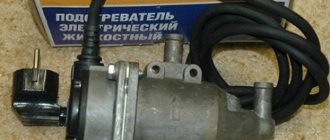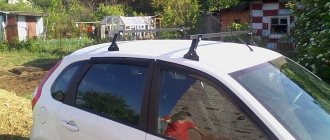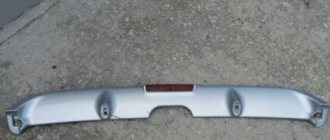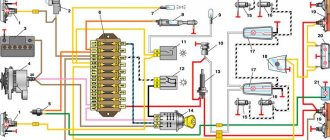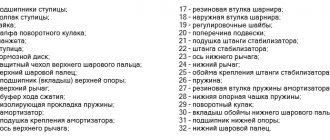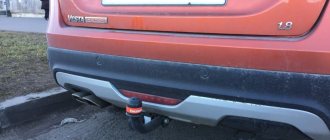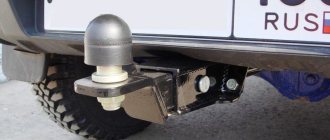How to replace the front crankshaft seal on a VAZ 2110-VAZ 2112?
The note!
This article covers the process of replacing the oil seal on 16 valve engines only, if you have 8 10 valves, then in that case, go to the article entitled "Replacing a Crankshaft Seal on 9s" in it, with an example of an 8 cylinder engine, everything is described!
Conclusion:
To remove the oil seal, first remove the timing belt from all the upper pulleys and rollers (as explained in the article on replacing the timing belt on a car, we already mentioned the link to this article at the very beginning of the article, scroll up), then the alternator belt will be removed, you need to remove the crankshaft pulley (How to remove the belt, described in the article: “Replacing the alternator belt on a VAZ”), after completing the operations, proceed to removing the large and small crankshaft mechanism, both gears are fixed with one bolt (it holds them in the center ), which is there (see photo 1), but to get to it, the jack must lift the right side (when you look at the car, see), remove the wheel (see article: Correct replacement of wheels on cars) and, if necessary, remove the wheelbarrow , if the suspension does not interfere, then without removing it, turn the pulley bolt and first of all, remove the large pulley from the crankshaft, install a washer on it without losing it, remove it from the large crankshaft pulley (see picture). photo 2), follow the belt with a small release of the pulley (see photo 3), and at the end remove the small pulley from the shaft, that's all, you can assume that you have hit the packing, but there is one caveat, there is a key (see
photo 4), when this is done, you can remove the oil pump cover seal using thin screwdrivers, when you remove it, note that it is on the side, Install the new packing in the same way
Any part of a modern car, no matter how high-quality and reliable it is, has its own working life, upon reaching which it must be replaced, which allows for the most comfortable and safe operation of the entire propulsion system. Crankshaft oil seals are no exception; they should be diagnosed and replaced approximately every three years. Today we will talk about how to replace the front crankshaft oil seal at home.
Crankshaft pulley
The generator and water pump on the VAZ 2106 are driven by a belt from the crankshaft pulley. When carrying out repair work on the engine, attention should also be paid to the condition of the pulley: is there any visible damage (cracks, scuffs, dents). If defects are found, the part should be replaced.
When repairing an engine, carefully inspect the crankshaft pulley for damage. If defects are found, the part must be replaced
During the installation process, the pulley should sit smoothly on the crankshaft, without distortion. Despite the fact that the pulley fits quite tightly on the shaft, a key is used to prevent rotation, which can also be damaged. A defective part must be replaced.
To protect the crankshaft pulley from turning, a key is used. The part may break over time, which indicates the need to replace it.
Crankshaft marks
In order for the engine to work flawlessly, after installing the crankshaft, the correct ignition setting is necessary. There is a special casting on the crankshaft pulley, and on the cylinder block there are three marks (two short and one long) corresponding to the ignition timing. The first two indicate an angle of 5˚ and 10˚, and the long one - 0˚ (TDC).
There are marks on the crankshaft pulley and on the cylinder block by which the first piston is installed at TDC for correct ignition adjustment
The mark on the crankshaft pulley is located opposite the length of the marks on the cylinder block. There is also a mark on the camshaft sprocket that must be aligned with the casting on the bearing housing. To rotate the crankshaft, use a special wrench of the appropriate size. According to the marked marks, the piston of the first cylinder is at top dead center, while the slider on the ignition distributor must be installed opposite the contact of the first cylinder.
Despite the fact that the crankshaft is a critical component of any engine, even a novice auto mechanic can repair the mechanism, with the exception of the grinding stage. The main thing is to select the elements according to the dimensions of the shaft, and then follow the step-by-step instructions for assembling it.
When may repair dimensions of crankshafts be required?
First of all, let's look at the different types of defects that occur, as well as the reasons for their occurrence. If the geometry of the seats for the support bearings of the block is broken, rapid wear of the journals should be expected. In other words, if this process is observed, the reason is most likely exactly the same as indicated above, or in the poor quality of the material of the shaft itself. Due to poor-quality oil or its irregular replacement, scuffs may appear on the necks; a clogged oil filter, or, which is even worse, low pressure in the system, can also be the source of this trouble.
Toyota pistons markings
The pistons on Toyota engines also have their own designations and sizes. For example, on the popular Land Cruiser, the pistons are designated by the English letters A, B and C, as well as numbers from 1 to 3. Accordingly, the letters indicate the size of the hole for the piston pin, and the numbers indicate the size of the piston diameter in the “skirt” area. The repair piston has +0.5 mm compared to the standard diameter. That is, only the letter designations change for repair shops.
Please note that when purchasing a used piston, it is necessary to measure the thermal gap between the piston skirt and the cylinder wall. It should be within 0.04...0.06 mm
Otherwise, it is necessary to carry out additional diagnostics of the engine and, if necessary, carry out repairs.
Pistons - replacement
To complete the work, you will need mandrels to remove the piston pin and compress the rings.
1. Place the car on an inspection hole or overpass (see “Preparing the car for maintenance and repair”).
2. Remove the cylinder head from the engine (see “Cylinder head gasket - replacement”).
3. Remove the engine sump (see “Engine sump - removal and installation”).
4. Unscrew the nuts of the connecting rod caps (without removing the crankshaft) and push the piston and connecting rod out of the cylinder block (see “Crankshaft - removal and installation”).
5. Remove the steel-aluminum liner from the connecting rod cover.
The connecting rod and cap are stamped with the number of the cylinder in which they are installed.
6. Place the connecting rod in a vice and remove two compression rings and one oil scraper ring with an expander from the piston.
7. Press the pin out of the connecting rod through the mandrel and remove the piston.
Similarly, remove the pistons of the remaining cylinders.
Before installing the piston group on the connecting rod, it is necessary to select its parts.
Selection of connecting rod and piston parts
1. Select the piston to the cylinder. The calculated gap between the cylinder and the engine piston should be 0.06-0.08 mm. It is determined by measuring the cylinders and pistons and is ensured by installing pistons of the same class as the cylinders. The maximum permissible gap is 0.15 mm. The piston diameter is measured in a plane perpendicular to the piston pin, at a distance of 52.4 mm from the piston bottom. The outer diameter of the pistons is made into five classes (A, B, C, D and E) every 0.01 mm, and the diameter of the hole for the piston pin is made into three categories every 0.004 mm. Spare parts include pistons of groups A, C and E. The piston class (letter) and the category of the piston pin hole (number) are stamped on the piston bottom.
For correct orientation of the piston relative to the cylinder, there is a “P” mark on the piston wall (next to the boss), which should be directed towards the front of the cylinder block.
Is it possible to tune the Priora 126 engine?
Even with a strong desire, the 126 engine will not be able to reach a speed of 100 km/h in a few seconds. Without tuning the Lada Priora engine, overtaking prestigious brands will also not be possible.
According to many motorists, it is necessary to install a turbocharger from the very beginning. In this case, the engine power will increase by no more than 15 - 20%. Special filter elements are additionally installed here to clean the cold air as it enters the engine.
The main improvements to the 21126 motor are:
- cylinder boring;
- increase in piston stroke.
With the help of these modifications, it is possible to most effectively boost the 126 engine, the power of which increases by 50 horsepower. The main purpose of boring is to increase the volume of the cylinders. The process comes down to primitive actions:
- cylinder walls are reduced in thickness;
- more gasoline is burned in the resulting volume;
- engine performance increases;
- power increases.
When choosing a future car, we definitely pay attention to what kind of power unit (heart) it has. Not only the dynamics depend on the motor, but also how much money is required for its maintenance
Do you know which modern VAZ engine to choose?
Thermal clearance of piston rings
PCs are spring discs with one cut - when installed on the piston, they expand, and in the sleeve they are pressed tightly against its walls. In order to achieve maximum compression of the working mixture, the cylinder walls must be as smooth as possible (without defects), and the shape of the internal cavity must be perfectly round. On the piston, the PCs are placed in special grooves, moreover, they are not seated tightly, and on a cold piston they move freely in the grooves.
Piston rings have thermal clearances:
The clearances must be certain; if they are larger or smaller than the required value, the piston group will quickly fail. One should take into account the fact that when heated, the metal expands, and if the thermal gap of the PC is too small, the piston group will begin to overheat. With large gaps, tightness is not ensured and power losses occur.
For passenger cars, as a rule, the following clearances are established:
- between the grooves and the PDA - from 0.02 to 0.08 mm (for the upper ring the gap should be slightly larger);
- between grooves and MPC – from 0.05 to 0.06 mm;
- at the junction - from 0.25 to 0.5 mm.
As wear occurs, the gaps in the PC increase, and they should not exceed:
When repair dimensions of crankshafts are required
The transition point from the main or connecting rod journal to the cheek experiences the greatest loads in the crankshaft structure, and therefore wear in this place is the greatest. As the motor operates, scuffs and cracks appear on the journals, which lead to a violation of the geometry of the shaft and must be eliminated as soon as possible. They can be removed by sanding. In order for the engine to operate in a balanced manner and without unnecessary vibration, the new dimensions of the crankshaft main and connecting rod journals must be precisely adjusted to the shaft and to each other. This is done using special inserts. For the convenience of auto mechanics, the diameters of the necks and the thickness of the liners were standardized for each car model.
Therefore, repair dimensions are required every time the crankshaft is ground. They are determined depending on the shaft processing method. During production, each shaft goes through several stages of hardening, increasing the strength and wear resistance of its surface. Most often, heat treatment is used, but in some cases, to enhance strength, the effects of high and low temperatures are combined with chemical treatment (high-frequency hardening, nitriding, hardening of the surface layer). As a result, a sufficient depth of the hardened layer is achieved so that the shaft journals can be ground 4–6 times without losing the working qualities of the shaft.
Crankshaft sample Crankshaft design:
- The main journal is the supporting part of the shaft. It is located in the engine crankcase and rests on the main bearing.
- The connecting rod journal connects the shaft to the connecting rods and at the same time ensures the supply of lubricant to them through special channels.
- Cheeks are parts connecting the main and connecting rod journals.
- The front output portion of the shaft, or toe, is where the timing gear or power take-off pulley is mounted.
- The rear output shaft or shank is where the flywheel or power take-off gear is mounted.
- Counterweights are structurally a continuation of the cheeks and remove part of the load from the main bearings.
Be sure to read: Repair of the MTZ 80 front axle, its structure and diagram
VAZ pistons marking
According to statistics, owners or engine repair technicians of VAZ cars are most often interested in the marking of repair pistons. Below we provide information on various pistons.
VAZ 2110
For example, let's take the engine of a VAZ-2110 car. Most often, this model uses pistons marked 1004015. The product is produced directly at AvtoVAZ OJSC. Brief technical information:
- nominal piston diameter - 82.0 mm;
- piston diameter after first repair - 82.4 mm;
- piston diameter after the second repair - 82.8 mm;
- piston height - 65.9;
- compression height - 37.9 mm;
- The recommended clearance in the cylinder is 0.025...0.045 mm.
Additional information can be printed directly on the piston body. For example:
- “21” and “10” in the area of the hole for the finger - designation of the product model (other options - “213” indicates the VAZ 21213 engine, and for example, “23” - VAZ 2123);
- “VAZ” on the inside of the skirt is the manufacturer’s designation;
- letters and numbers on the inside of the skirt are a specific designation of foundry equipment (you can decipher it using the manufacturer’s documentation, but in most cases this information is useless);
- “AL34” on the inner side of the skirt is the designation of the cast alloy.
The main marking symbols applied to the piston crown:
- The arrow is an orientation marker indicating the direction towards the camshaft drive. On the so-called “classic” VAZ models, sometimes instead of an arrow you can see the letter “P”, which means “in front”. Likewise, the edge where the letter is depicted should be directed towards the direction of movement of the car.
- One of the following symbols is A, B, C, D, E. These are diameter class markers that show the deviation in the outside diameter value. Below is a table with specific values.
- Piston mass group markers. “G” is normal weight, “+” is weight increased by 5 grams, “-” is weight decreased by 5 grams.
- One of the numbers is 1, 2, 3. This is a piston pin hole class marker that determines the deviation in the diameter of the piston pin hole. In addition to this, there is a color designation for this parameter. So, the paint is applied to the inside of the bottom. Blue color - 1st grade, green - 2nd grade, red - 3rd grade. The following provides additional information.
For VAZ repair pistons there are also two separate designations:
- triangle - first repair (diameter increased by 0.4 mm from the nominal size);
- square - second repair (diameter increased by 0.8 mm from the nominal size).
Please note that for different brands of cars (including for different engines), the difference between repair pistons should be found in the reference information
VAZ 21083
Another popular VAZ piston is 21083-1004015. It is also produced at OJSC AvtoVAZ. Its technical dimensions and parameters:
- nominal diameter - 82 mm;
- diameter after first repair - 82.4 mm;
- diameter after the second repair - 82.8 mm;
- piston pin diameter - 22 mm.
It has similar designations as VAZ 2110-1004015. Let us dwell in a little more detail on the class of the piston in terms of outer diameter and the class of the hole for the piston pin. The relevant information is summarized in tables.
| Piston class by outer diameter | A | B | C | D | E |
| Piston diameter 82.0 (mm) | 81,965-81,975 | 81,975-81,985 | 81,985-81,995 | 81,995-82,005 | 82,005-82,015 |
| Piston diameter 82.4 (mm) | 82,365-82,375 | 82,375-82,385 | 82,385-82,395 | 82,395-82,405 | 82,405-82,415 |
| Piston diameter 82.8 (mm) | 82,765-82,775 | 82,775-82,785 | 82,785-82,795 | 82,795-82,805 | 82,805-82,815 |
It is interesting that the VAZ 11194 and VAZ 21126 piston models are produced only in three classes - A, B and C. In this case, the step size corresponds to 0.01 mm.
Correspondence table between piston models and engine models (brand) of VAZ cars.
| VAZ engine model | Piston model | |||||||||||
| 2101 | 21011 | 2105 | 21213 | 2123 | 2108 | 21083 | 2110 | 2112 | 21124 | 21126 | 21128 | 11194 |
| 2101 | ||||||||||||
| 21011 | ||||||||||||
| 2103 | ||||||||||||
| 2104 | ||||||||||||
| 2105 | ||||||||||||
| 2106 | ||||||||||||
| 21073 | ||||||||||||
| 2121 | ||||||||||||
| 21213 | ||||||||||||
| 21214 | ||||||||||||
| 2123 | ||||||||||||
| 2130 | ||||||||||||
| 2108 | ||||||||||||
| 21081 | ||||||||||||
| 21083 | ||||||||||||
| 2110 | ||||||||||||
| 2111 | ||||||||||||
| 21114 | ||||||||||||
| 11183 | ||||||||||||
| 2112 | ||||||||||||
| 21124 | ||||||||||||
| 21126 | ||||||||||||
| 21128 | ||||||||||||
| 11194 |
Piston pin holes:
| Piston pin hole class | 1 | 2 | 3 |
| Piston pin hole diameter(mm) | 21,982-21,986 | 21,986-21,990 | 21,990-21,994 |
Help on the sizes of VAZ classic engines.
The height of the cylinder block for a classic VAZ car (from the crankshaft axis to the plane of the cylinder head gasket): - 2101, 21011, 2105 = 207.1 tolerance -0.15, - 2103, 2106, 2121, 21033 (for 76 gasoline for China) , 2130 (1.8 liters OPP) = 215.9 tolerance -0.15, - 21213 (on motor 21214 block 21213) = 214.58 tolerance -0.15.
The thickness of the cylinder walls usually allows the diameter to be increased by no more than 2 mm; if the water jacket, or rather the diameter of the cylinder, is shifted relative to the jacket, problems may arise. Knee stroke 2101, 2103, 21213: stroke 2101 - 66mm (in everyday life called low) stroke 2103 - 80mm stroke 21213 - 80mm (more balanced due to more developed counterweights, apparently to the detriment of weight) stroke 2130 - 82mm There are Tyunen knees with a stroke of 84, 86.88 mm. But they cost from 10 thousand
The diameter of the pistons for the classic 2101 is 76mm 21011,2105 is 79mm 21213 is 82mm 2108 is 82mm (installed for driving on a 76 Benz, for export) There are many forged pistons of any stock diameter, and a maximum of 84mm. One of the main geometric characteristics of the piston is the compression height. It is determined by the distance from its bottom to the piston pin axis. For a classic VAZ engine it is 38 mm. There are pistons with a lower compression height, such as TPT pistons. The height is 31 mm.
Lengths of connecting rods for classic engines (what are there): All connecting rods 2101 are 136 mm long, but there is a connecting rod 213 that is the same length, but there the pin is pressed into the piston and not into the connecting rod. There are connecting rods that are shortened by 7mm (as an example: push the 80th knee into a low block) There are two types: shortened - they are made immediately 7mm shorter (they make them somewhere in Ukraine), and seated, that is, they take a stock connecting rod and shrink it under heat, they did it at scoop, but they are not very desirable, and in general opinion are dangerous, since there will certainly be tension at the place of shrinkage, and the “hand of friendship” may appear
We have an engine 2101 or 21011 with volumes of 1.2 and 1.3 respectively, what can we get? from 2101 blocks we can get volumes of 1.5 and 1.6 liters, from 21011 blocks 1.6 and 1.7. What is needed for this? 1. Crankshaft 2103 (if you hear a crankshaft 2106 or 2121, then keep in mind that the engine 2106 has a KV 2103, the Niva 2121(!) had a 2106 engine), or 21213 (it will be better) 2. Connecting rods Shortened, if we increase the volume connecting rods, then you can leave the original pistons, it all depends on the service life of the engine, if we sharpen then take new pistons))) 3. Pistons (If we install original or 213 connecting rods)
An example of obtaining 1.7 liters on block 011: 1. Crankshaft 2. Connecting rod 129 mm (as an option, either original or 213) 3. Pistons 82 mm (here it depends on the connecting rod, if it is shortened then we install a Nivov piston from engines 21213, if the connecting rod will it be native or 213, then we install a piston with a lower compression height) 4. We sharpen the cylinders to 82 mm This turns out to be 1.7 liters))) For volumes 1.5 and 1.6 the same order, only we will choose between connecting rods and pistons , in this case there is such a thing as R/S (rod to stroke ratio) - the difference between the length of the connecting rod and the stroke of the crankshaft. And quite serious attention is paid to it when refining engines. Many sources believe that the “golden mean” is an R / S value of 1.75
PRO: Allows the piston to remain at TDC longer, which ensures better combustion of the fuel mixture, i.e. more complete combustion of the fuel mixture, higher pressure on the piston after passing TDC, higher temperature in the combustion chamber. The result is good torque at medium and high speeds. A long connecting rod reduces friction of the piston-cylinder pair, and this is especially important during the working stroke of the piston.
CONS: A motor assembled with a sufficiently large R/S value does not provide good filling of the cylinders at low and medium HF rotation speeds, due to a decrease in air flow speed (due to a decrease in the piston speed after TDC, at the moment the intake valve opens). There is a high probability of detonation due to the high temperature in the combustion chamber and the long time the piston remains at TDC.
PROS: Provides a very good cylinder filling speed at low and medium HF rotation speeds, since the piston speed from TDC is higher, the vacuum increases faster, which improves cylinder filling, a higher speed of the air-fuel mixture makes the mixture more homogeneous (homogeneous), which contributes to better combustion. Advantages: Lower requirements for rework and cylinder head bore diameters than on an engine with a high R/S ratio.
CONS: A small RS value means a larger crank angle. This means that a large force will push the piston in a horizontal plane. For the motor this means the following:
1. Large load on the connecting rod (especially on the center of the connecting rod), which makes destruction of the connecting rod more likely. Destruction of the connecting rod itself is unlikely, except in cases of breakage, when jamming and water hammer, as a rule, the connecting rod breaks at the upper or lower head at an angle of approximately 45 degrees to the axis of the connecting rod. 2. Increased load on the walls of the cylinder block, greater load on the pistons and rings, increased operating temperature due to increased friction, as a result, faster wear of the cylinder walls, rings, and deterioration of lubrication conditions. The wear of this area depends on the amount of displacement of the pin axis rel. piston axis and on the value of the maximum angle of inclination of the connecting rod, i.e. When using “forged” pistons with an offset pin, wear will be less than when using standard pistons. 3. A shorter connecting rod also increases the speed of the piston, which affects wear and increases friction. The maximum piston speed occurs at an angle of about 80 degrees of rotation of the crankshaft from TDC; for an engine with a 74.8 mm crankshaft at 5600 rpm it is equal to 22.92 m/s with a connecting rod of 121 mm, and 22.80 m/s. with a connecting rod of 129 mm.
The most significant is the dependence of the piston acceleration on the length of the connecting rod. Large acceleration values have a positive effect on cylinder filling at low speeds, which leads to a “torque” engine due to better filling. But at high speeds, due to the inertia of the flow in the intake pipe, a blocking effect occurs on the intake valve (that is, the volume of the cylinder above the piston grows faster than it can be filled through the valve gap, which leads to deterioration in filling and power characteristics at high speeds). In the case of a long connecting rod, a reverse ejection of the mixture occurs at low speeds, but at high speeds there is no locking phenomenon.
Technical characteristics of VAZ 2106
Performance characteristics of the VAZ 2106 six Maximum speed: 150 km/h Acceleration time to 100 km/h: 17.5 s Fuel consumption per 100 km in the city: 10.1 l Gas tank volume: 39 l Curb vehicle weight: 1035 kg Permissible gross weight: 1435 kg Tire size: 175/70 SR13
Engine characteristics
Position: front, longitudinal Engine capacity: 1569 cm3 Engine power: 75 hp Number of revolutions: 5400 Torque: 116/3000 N*m Power system: Carburetor Turbocharging: no Gas distribution mechanism: OHC Cylinder arrangement: In-line Number of cylinders: 4 Cylinder diameter: 79 mm Piston stroke: 80 mm Compression ratio: 8.5 Number of valves per cylinder : 2 Recommended fuel: AI-92
Brake system
Front brakes: Disc Rear brakes: Drum
Steering
Steering Type: Worm Gear Power Steering: No
Transmission
Drive: Rear Number of gears: manual gearbox - 4 Gear ratio of the main pair: 4.1
Suspension
Front suspension: Double wishbone Rear suspension: Coil spring
Body
Body type: sedan Number of doors: 4 Number of seats: 5 Vehicle length: 4166 mm Vehicle width: 1611 mm Vehicle height: 1440 mm Wheelbase: 2424 mm Front track: 1365 mm Rear track: 1321 mm Ground clearance (clearance): 170 mm Trunk volume: 345 l
Production
Year of manufacture: from 1976 to 2005
Modifications of VAZ 2106
VAZ-21061 - VAZ-2103 engine with a volume of 1500 cm3. Initially, this index was supposed to denote a special version for Canada, which included being equipped with special bumpers - aluminum, without fangs, with linings and ends made of black plastic.
VAZ-21062 is an export modification of the VAZ-2106 with right-hand drive.
VAZ-21063 is an improved version of the VAZ-21011 engine, with an oil pressure sensor and an electric fan instead of a belt-driven impeller (in a variant, belt drive was allowed).
VAZ-21064 is an export modification of the VAZ-21061 with right-hand drive.
VAZ-21065 is a modernized modification with improved equipment, produced in 1990 - 2001. It differed from the base model by a more powerful generator, a five-speed gearbox, a rear axle gearbox with a gear ratio of 3.9, a contactless ignition system, a Solex carburetor (21053-1107010), halogen headlights, seat upholstery and headrests, as well as a standard rear fog lamp and electrically heated rear window. Equipment 21065-01 was equipped with an engine from model 2103.
VAZ-21066 is an export modification of the VAZ-21063 with right-hand drive.
VAZ-21067 - IzhAvto assemblies. The VAZ-21067 engine, which differs from the base one by the presence of a fuel injection system with a catalytic converter, which ensures compliance with Euro-2 toxicity standards.
VAZ-21068 - was released as a carrier of units during the development period of the new VAZ-2108 and VAZ-21083 engines.
VAZ-21069 - cars were manufactured for special services. Externally, it is completely identical to the VAZ-2106, but with a two-section VAZ-411 RPD with a power of 120 hp. Since 1983, a VAZ-413 engine with a power of 140 hp could be installed, and since 1997, a universal RPD for rear-wheel drive and front-wheel drive VAZ VAZ-415.
VAZ-2106 “Tourist” is a pickup truck with a tent built into the body, created by order of the technical directorate. The project was rejected by the plant's head management, and the only silver copy was repainted red and subsequently used as in-plant technical equipment.
VAZ-2106 “Half past six” is the only copy made according to a special order received from L.I. Brezhnev or someone from his entourage after the demonstration of experienced VAZ-2107 to the top leadership of the USSR in 1979. In addition to export bumpers, it was distinguished by seats and grille radiator from 2107, as well as a hood modified for its installation.
What engine can be installed on a VAZ 2103 instead of the standard one?
Domestic cars are good because with a sufficient budget it will be possible to implement almost any planned project. Even when connecting the engine to the gearbox there are no particular difficulties. Thus, almost any power unit is suitable for the VAZ 2103. The main thing is that it must fit in size.
Rotary engine
Until a certain time, only special police forces and the KGB were armed with cars with such engines. However, tuning enthusiasts in the USSR, folk craftsmen, found and installed a rotary piston engine (RPE) on their VAZ 2103.
The RPD can be easily installed on any VAZ car. It goes to Moskvich and Volga in a three-section version.
The rotary piston engine can be easily installed on any VAZ car
Diesel engine
The diesel engine is mated to the standard VAZ 2103 gearbox using an adapter plate, although the gear ratios of the engines are not at all suitable.
- Driving with a diesel Volkswagen Jetta Mk3 will not be very comfortable, especially after 70–80 km/h.
- The option with a diesel unit from the Ford Sierra is a little better. In this case, you will have to change the design of the tunnel, install a gearbox from a BMW and make some other changes.
Motors from foreign cars
In general, foreign-made engines have been and are often installed on the VAZ 2103. True, it is impossible to avoid additional modifications in this case.
- The most popular engine is the Fiat Argenta 2.0i. About half of the owners of tuned “threes” installed these engines. There are practically no problems with installation, however, the engine is a bit old, which is unlikely to please the owner.
- Engines from BMW M10, M20 or M40 are also suitable. We have to modify the struts, rework the flywheel and replace the axles.
- Engines from Renault Logan and Mitsubishi Galant are praised by craftsmen, but in these cases the gearbox has to be changed.
- And, probably, the best option is the power plant from Volkswagen 2.0i 2E. True, such an engine is not cheap.
Crankshaft repair
Grinding of the crankshaft is performed on a rotating emery wheel. During operation, the shaft is rotated around the base axes of either the main or connecting rod journals. It is also necessary to ensure that the center-to-center condition is maintained and to be extremely careful about maintaining the shape of the fillets, otherwise repairs can only accelerate the destruction of the crankshaft.
After grinding, the shaft and flywheel assembly must be dynamically balanced to avoid vibration in the rebuilt engine. However, in practice this condition is rarely met, especially during individual repairs.
In some cases, it is impossible to repair damage to the journals by grinding. Then you can consider the option of surfacing or spraying (including plasma) followed by grinding to zero (nominal) size. Depending on the material being deposited, the strength of the journal may even increase compared to factory values. At the final stage of processing, the journals are polished and finished to achieve the optimal degree of roughness.
It is important to take into account that the sizes of necks of the same type must necessarily match. Different types may have different diameters
For example, the main ones can be of the second repair size, and the connecting rods can be of the third. The exception is situations of field repair, in which the journals may not have a standard repair size at all.
It should also be noted that the specific loads placed on the crankshaft often cause its failure. Most often this happens due to an increase in gaps with the liner, which entails deterioration of lubrication. A broken crankshaft cannot be repaired and must be replaced.
Calculation of VAZ engine volume, selection of crankshaft
Engine Connecting Rod - Conrod
| Connecting rod length | Neck diameter | Piston pin | Finger fit type | Name |
| 121 | 47,8 | 22 | pressing * | 2108 "standard" |
| 121 | 47,8 | 22 | floating | 2110-12 "standard" |
| 126,4 | 47,8 | 22 | floating | 2110 tuning |
| 129 | 41,5 | 19 | floating | 21128 “standard” - original inserts 21128 |
| 129 |
47.8 22 press-fit 2101 tuning 129.2 47.8 22 floating 2110 tuning
129.2 47.8 20 floating 2110 tuning
131 47.8 19 floating 2110 tuning
133 47.8 19 floating 2110 tuning (STI 217.02)
133 47.8 19 floating 2110 tuning (STI 216.55, H-shaped)
135.1 47.8 19 floating 2110 tuning (STI 216.50, H-shaped)
136 47.8 22 press-fit 2101 “standard”, until 1982 they were produced with an oil nozzle
136 47.8 22 floating 21213 “standard”
Crankshafts – Crankshafts – Cranks
| Piston stroke | crank radius | Crankshaft name |
| 66 | 33 | 66 * 2101 "standard" |
| 80 | 40 | 80 * 2103 "standard" |
| 80 | 40 | 80 * 21213 “standard” - full counterweight |
| 84 | 42 | 86*tuning |
| 86 | 43 | 86*tuning |
| 88 | 44 | 88*tuning |
| 90 | 45 | 90 * tuning (crankpin 43mm) |
| 60,6 | 30,3 | 60.6 * 2108 "standard" |
| 71 | 35,5 | * 21083-12 f"standard" |
| 74,8 | 37,4 | * tuning |
| 74,8 | 37,4 | 74.8 * tuning (STI 116.50, full counterweight) |
| 75,6 | 37,8 | 11183 "standard" |
| 78 | 39 | 78 * tuning |
| 79 | 39,5 | 79*tuning |
| 80 | 40 | 80*tuning |
| 80 | 40 | 80 * tuning (STI 218.00) |
| 83 | 41,5 | 83 * tuning (STI, on order) |
| 84 | 42 | 84 * tuning (STI, on order) |
| 84 | 42 | 84 * 21128 factory stock (STI 218.00, for connecting rods 21128 and bearings 21128) |
| 86 | 43 | 86*tuning |
| 88 | 44 | 88 * tuning (crankpin 45mm) |
Cylinder Blocks
Block height is the distance between the geometric center of the crankshaft and the top plane of the cylinder block.
| Height mm. | cylinder diameter | Name |
| 207,1 | 76 | Block 2101 cylinder diameter 76mm |
| 207,1 | 79 | Block 21011 cylinder diameter 79mm |
| 215,9 | 76 | Block 2103 cylinder diameter 76mm |
| 215,9 | 79 | Block 2106 cylinder diameter 79mm |
| 214,58 | 82 | Cylinder block 21213 |
| 194,8 | 76 | Block 2108 cylinder diameter 76mm |
| 194,8 | 82 | Block 21083 cylinder diameter 82mm |
| 194,8 | 82 | Block 2112 cylinder diameter 82mm |
| 197,1 | 82 | Block 21124 cylinder diameter 82mm |
| 197,1 | 82 | Cylinder block 2108-2112 Kalina (+2.3mm) |
| 198,3 | 82 | Cylinder block 2108-2112 (+3.5mm) |
| 199,3 | 82 | Cylinder block 2108-2112 (+4.5mm) |
| 199,5 | 82 | Cylinder block 2108-2112 (+4.7mm) |
Classic configuration options
| Engine | 2103 | 2106 | 21213 | 1900cc | 2000cc | 2000cc | 1800cc |
| Piston stroke: | 80 | 80 | 80 | 84 | 88 | 90 | 84 |
76 79 82 84 84 84 82.4 Volume cm3. 1450 1567 1690 1861 1950 1994 1790
VAZ piston shortfall 1.6 mm - the distance between the piston at the top dead center and the plane of the cylinder block.
The volume of the VAZ classic combustion chamber is 33.2 mm2.
| initial data |
| piston stroke: | mm |
| cylinder diameter: | mm |
| Porsche chamber volume: | cc |
| piston shortfall: | mm |
| chamber volume in cylinder head: | cc |
| cylinder head gasket: | cc |
result
engine capacity: 1583.66 cc
compression ratio: 9.38:1
AUTO-KOR.RU
daewoo chevrolet hyundai
, -2108 . 150. 0,1 ( ) . , 30 160. 200 .
1. . . , : 025 — , , 0,25 . , : 050, 075, 100. . ( ) . , . , . .
2. . (2,310-2,360 ) (2,437-2,487 ).
3. , 0,06-0,26 . (0,35 ), , 0,127 .
Size of repair pistons VAZ 2103
The piston stroke of the VAZ 2103 car engine is 80 (mm), the compression ratio is 8.5 units.
The piston is the main part of the internal combustion engine, which performs the function of converting the energy of fuel combustion into the mechanical work of the engine.
The material used for the manufacture of pistons for this VAZ model is aluminum alloy coated with tin.
Dimensions of pistons for VAZ 2103 1.5 MT:
- Piston stroke: 80 (mm);
- Compression ratio: 8.5;
- Piston diameter: 76.00 - 76.05 (mm);
- Years of production: 1972 - 1983.
Important: some modifications of this model (VAZ 21033 and VAZ 21033) are equipped with a 66 (mm) stroke piston.
The 4-door sedan VAZ 2103 was exported under the names VAZ 2107, VAZ 1500, Lada Nova, Lada Riva, Lada Signet, Lada 1500.
Important: years of production of all modifications of the model: 1972-1984.
| General view General view of the pistons |
Caution: The above data are the official figures of the manufacturer, however, please note that the information is for reference only and is not guaranteed to be completely accurate.
Source of the article: https://razmery.info/tehnika/porshni/razmery-porshney-vaz-2103.html
How to replace bearings without removing the engine?
Many car owners think and write on forums that it is impossible to get to the liners without removing or removing them from the engine hood. However, such operations are carried out by repairmen on ships, where the size of the parts is enormous and too much force is required to remove the engine. And if the technique exists, it can be used for simple cars.
- Park the vehicle on a ramp to gain easy access to the engine. If there is protection installed on it, it should be removed and the lubricant drained.
- Remove the box, front cover and loosen the camshaft chain in advance. If you're not too lazy, it's better to remove it entirely so it doesn't interfere.
- Remove the starter and pan (if the beam does not interfere). If it interferes with operation, you will have to lift the motor and pull out the pan from under it.
- You now have access to the crankshaft. The easiest way is to replace the connecting rod bearings. The old bearings are pulled out after unscrewing the head screws; it’s easy to put new ones in place, just don’t forget to lubricate them well with the same engine oil that is in your engine.
- It is more difficult to replace the main bearings without removing the engine. You will need to lower the crankshaft by loosening its fastening. You don’t need to lower it much, ten, maximum fifteen centimeters.
- Now it will be easier to pull out the earbuds. But you will need an aluminum rivet, which must be inserted into the lubrication hole, so it will push the bearing out. The main thing is that the size of the rivet is suitable and does not scratch the crankshaft.
Repair
Replacing main bearings requires wrench and screwdriver sets and a micrometer. Repair of main liners includes several operations.
- First of all, you need to provide access to the car from below. That is, it should be installed above an inspection hole or on an overpass.
- Remove the negative wire from the battery terminal.
- Next, dismantle the engine sump (this is the easiest way to access; you can start disassembling from above and hang the engine).
- After this, the crankshaft rear oil seal holder is removed from the cylinder block.
- Then remove the camshaft drive cover with the gasket.
- Then remove the chain from the crankshaft sprocket-pulley.
- Next, you need to mark the relative position of the bearing caps relative to the cylinder block and the connecting rods relative to their caps.
- Then, using a 14mm wrench, unscrew the nuts of the connecting rod cover and dismantle it with the liner.
- These operations are repeated for all connecting rods.
- When completed, the lids are moved up.
- Then the main bearings are removed from the caps and connecting rods.
- Next, use a 17 wrench to unscrew the bolts of the crankshaft main bearing caps.
- First, remove the cover of the last one.
- It opens access to the thrust half-rings in the grooves of the rear crankshaft support. They are removed by pressing on the ends with a thin screwdriver.
- These operations are repeated for the remaining bearing caps. In this case, you need to hold the crankshaft. It should be noted that the covers are designated by numbers, and the countdown is from the toe of the crankshaft.
- It is then removed from the crankcase.
- First, the connecting rod bearings are removed, and then the crankshaft main bearings.
- The crankshaft should be inspected for damage. If they are present, the part is changed.
- The connecting rod and main caps are also examined by measuring with a micrometer. The obtained data are correlated with the tabular ones.
- If necessary, parts are polished. In this case, you will need to measure them to calculate the repair size of the liners.
- The crankshaft is cleaned by washing with kerosene and blowing out the cavities.
- Then new bearing shells are installed.
- Thrust half rings are mounted in the grooves of the fifth bearing bed with grooves towards the crankshaft.
- Next, check the gap between these parts. The normal value is considered 0.06-0.26 mm. If it is more than 0.35 mm, use rings of increased thickness.
- The crankshaft is installed in the block, having previously been lubricated with oil.
- Then install the bearing caps and check the freedom of rotation of the crankshaft.
- Connecting rods, liners and covers are installed on it.
- Then the oil pan is installed.
- After this, install the crankshaft holder with the rear oil seal.
- Finally, the remaining parts are installed.
- Finally, the tension of the timing chain, alternator belt and ignition timing are adjusted.
VAZ 2108 engine repair
We repair the VAZ 2108 engine after disassembling the engine, cleaning, washing and drying all the elements.1. Clean the piston head from carbon deposits. The piston should be replaced if there are burrs, burnouts, deep scratches, or cracks on it.2. Use a piece of wire to make holes for oil drainage.3. Adjust, if necessary, the gaps between the rings and grooves on the piston.4. Measure the gaps in the piston ring locks using a piston ring inserted into a special mandrel. The nominal clearance of the PC is 0.25-0.45 mm, as a result of wear, -1.0 mm is permissible. If the gap does not fall within these values, replace the PC.
5. If the gap is less than 0.25 mm, grind off the ends of the PC with a file.6. Measure the gaps between the pistons and cylinders. The nominal gap is 0.025-0.045 mm, permissible - 0.15 mm. If the gap is greater than 0.15 mm, bore the cylinders and install pistons of the required size. Measure7. Using a bore gauge, measure the diameters of the cylinder in two perpendicular planes and in 1, 2, 3 and 4 zones.8. When repairing a VAZ 2108 engine with replacing parts of the connecting rod and piston group, sort the pistons to the cylinders according to class and weight groups.
9. Opposite each cylinder, a group of cylinders is knocked out on the lower plane
10.If there are cracks on the piston pins, replace them. The piston pin should gently enter the piston using hand force. Replace the piston if there is any play in the piston pin in the piston.11. Replace bad piston rings and oil ring expander.
12. Replace bad retaining rings holding the piston pin.13. Replace bad connecting rods if there are burrs and scratches in bushing 1 of the upper head, and if during disassembly it is discovered that they have turned in the connecting rod.14. If there is play when rocking the piston pin, replace the connecting rod.15. In the engine of VAZ 2108 cars, the connecting rods are false to have one class.16. We replace the crankshaft if there are scratches on the surfaces on which the seals operate. 17. Measure the crankshaft journals. The nominal diameter of the main journals is 50.799-50.819. The nominal diameter of the connecting rod journals is 47.830-47.850. With a diameter of more than 0.03 mm, the journals need to be ground to reduce the diameter: 1. 0.25 mm;2. 0.5 mm;3. 0.75 mm;4. 1.00 mm.18. Replace the half rings if there are nicks, marks or scratches on the surfaces of the thrust half rings. It is not permissible to carry out any adjustment work on the half rings. 19. Measure the axial clearance of the crankshaft.
20. The nominal gap is 0.0b-0.26 mm, the permissible gap is 0.35 mm. If the gap is greater, replace the crankshaft.21. Check the connecting rod and main bearings for cracks and burrs. If there are any, then install new liners. It is prohibited to carry out any adjustment work on them. The nominal thickness of the main bearings is 1.824-1.831 mm. The nominal thickness of the connecting rod bearings is 1.723-1.730 mm. Repair dimensions: 1. by 0.25 mm;2. by 0.5 mm;3. by 0.75 mm;4. - by 1.00 mm.22. Measure the gaps between the main bearing shells and the crankshaft journals. The clearances between the liners and the crankshaft journals are equal to: Nominal clearance of main bearings -0.026-0.073 mm, permissible -0.15 mm. Nominal clearance of connecting rod bearings -0.02-0.07 mm, permissible -0.1 mm. If the gap is more, The crankshaft needs to be ground.23. Measure the runout of the crankshaft journals. The runout of the main journals should be no higher than 0.03 mm; The seating surface for the flywheel should be no higher than 0.04 mm, and that for pulleys and oil seals should be no higher than 0.05 mm.
24. Wash the crankshaft oil passages thoroughly.25. You shouldn’t press out the plugs yourself; it’s better to take them to a specialized workshop.26. Thoroughly clean the surfaces of the BC from gasket residues. Inspect the block for cracks; if present, replace the block complete with main bearing caps.27. Check the tightness of the BC cooling jacket: turn off the water pump and pour coolant into the jacket. If a leak is detected, the cylinder block must be replaced, since it is not sealed.28. Check the cylinders for scratches, burrs, etc., if found, then bore the cylinders or install a new cylinder head. If the defect is more than 0.8 mm, then the BC cannot be repaired and must be replaced.
29. Remove carbon deposits from the top of the cylinders. Check cylinder wear by measuring the cylinder diameters.
High-quality repair of a VAZ 2108 engine depends, first of all, on your attitude towards it. It is useful to know the exact mileage, when the oil in the engine and gearbox was changed, maintenance of elements and to know the costs associated with using the car. Analyzing your expenses for the year will give you the opportunity to think about your driving skills, the number of trips, your attitude towards the car and your budget.
Crankshaft VAZ 2101, 2102
The crankshaft is a five-bearing one, cast from cast iron. The surfaces of the shaft journals are hardened by high-frequency currents to a depth of 2–3 mm. At the rear end of the crankshaft there is a seat for the front bearing of the gearbox drive shaft, along the outer diameter of which the flywheel is centered.
The connecting rod and main journals of the crankshaft are connected by channels through which oil is supplied to lubricate the connecting rod bearings. The technological outlets of the channels are closed with cap plugs, which are pressed in and caulked at three points for reliability.
To extend the service life of the crankshaft, it is possible to regrind the crankshaft journals when their surfaces are worn or damaged. By grinding, the journal diameters are reduced by 0.25, 0.5, 0.75 and 1.00 mm.
Main and connecting rod bearing shells
The main and connecting rod bearings are made of steel and aluminum. The upper shells of the 1st, 2nd, 4th and 5th main bearings have a groove on the inner surface, and the lower ones without a groove (until 1987, the lower shells of these bearings were installed with a groove). The shells of the central (3rd) main bearing differ from the others in their larger width and the absence of a groove on the inner surface. All connecting rod bearing shells are without grooves, identical and interchangeable.
What's the result?
Taking into account the above information, we can conclude that the appearance of knocking in the engine is a sign for immediate cessation of operation of the vehicle. It should also be taken into account that the condition of the liners is greatly influenced by the operating temperature of the power unit. In other words, engine overheating can lead to cranking of the connecting rod or main bearings, engine jamming, etc. In this case, the engine may become completely unusable, as the crankshaft bed breaks, the crankshaft itself, the cylinder block, etc. fail.
As for engine oil, it is necessary to use only those fuels and lubricants that meet all the requirements and necessary approvals of the power unit manufacturer. Also, the oil and oil filter must be changed promptly to prevent dirt and mechanical particles from getting into the lubricant. The lubrication system itself also deserves increased attention, since decreased performance or malfunctions can lead to oil starvation, which significantly increases the risk of bearings turning.
Finally, we add that the gasoline engine needs to be warmed up after a cold start, then you need to drive without loads until the power plant reaches operating temperatures. In the case of a diesel engine, the engine warms up while driving; it is not recommended to sharply load the unit until it is completely warmed up. It should also be remembered that both a new engine and a motor after repair need to be run in, since loaded pairs and mating elements need to be ground in.
